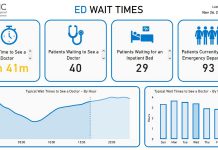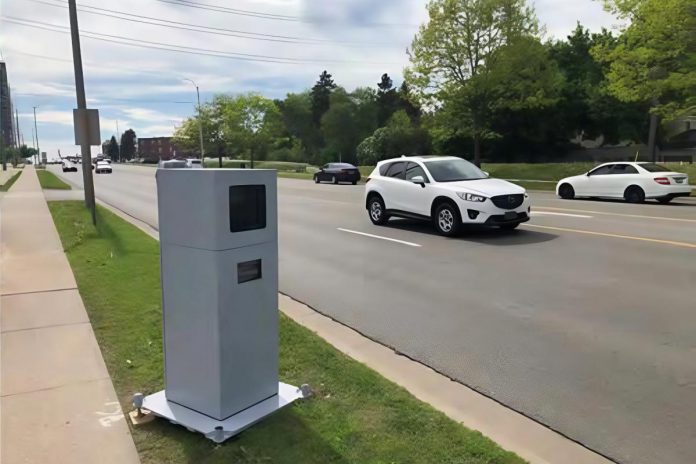Peterborough city council will be asked to endorse a proposal from city staff to implement speed cameras in school zones and community safety zones.
The report from Blair Nelson, the city’s commissioner of infrastructure, planning and growth management will be presented to city council at its general committee meeting on Monday (May 12). It follows council’s 2022 approval of phase four of the city’s transportation master plan, which included a recommendation to undertake feasibility studies for the implementation of red light cameras or automated speed enforcement to improve road and community safety.
Nelson’s report notes that, while council approved a city-wide speed limit reduction in school areas and the implementation of community safety zones 30 elementary and secondary schools in June 2023, and while that the measures resulted in a reduction of vehicle speeds by an average of 6.5 km/h, the current average operating speed is 11.5 km/h above the 40km/h posted speed.
According to the report, multiple municipalities in Ontario have implemented automated speed enforcement in school zones and community safety zones since the Ontario government passed the Safer School Zones Act in 2017, which amended the Highway Traffic Act to allow municipalities to use the measure, which “has proven to be an effective tool in reducing speeding and increasing compliance to the posted speed limit.”
“The Peterborough Police Service supports the implementation of automated speed enforcement in school and community safety zones,” the report states. “They currently conduct speed enforcement in these locations; however, resources do not allow for continual presence.”
The report adds that using speed cameras will allow police resources to be deployed elsewhere.
Automated speed enforcement is a technology-enabled enforcement system consisting of a speed measurement device and a camera that photographs vehicles exceeding the maximum posted speed. Offences captured by the system are reviewed and certified by provincial offences officers and issued to the vehicle’s registered owner.
While fines issued under the system do not result in demerit points or affect vehicle insurance, the Ministry of Transportation can deny licence plate renewals if the driver has outstanding fines.
Automated speed enforcement can consist of permanent camera installations or mobile versions, where the camera system is rotated to different locations. The most common approach is to use mobile cameras and rotate them to different locations, which increases the coverage area as well as the revenue generated by the cameras since compliance with speed limits increases the longer a camera stays at a single location.
“This approach, however, leads to the most common complaint with (automated speed enforcement) in that it is perceived as a ‘cash grab’ that does nothing to improve traffic safety,” the report states. “In many cases the average speed returns to pre-enforcement levels following the removal of the camera from the location. However, this method allows staff to better evaluate individual sites before investing in a permanent camera system.”
Along with the speed cameras, automated speed enforcement requires a data processing centre that can either be a contracted service, a centre operated jointly by municipalities, or an in-house centre. The report recommends that the City of Peterborough partner with the City of Toronto’s joint processing centre, which is currently used by 16 upper and lower-tier municipalities.
Offences can either be processed through the provincial court system or through a municipality’s administrative penalty system, with the report recommending that City of Peterborough use the City of Toronto’s administrative penalty system through its joint processing centre. The cost to the city of using Toronto’s system is around $20 per offence, along with a one-time startup cost of $55,000.
City staff are proposing a phased deployment of automated speed enforcement by initially securing four mobile cameras in 2025-26 for a two-year period. The city would acquire the cameras from RedFlex Traffic Systems (the City of Toronto’s selected camera vendor), which would install and maintain the cameras.
“This approach will allow staff to validate site selection, compliance rate, camera rotation logistics, cost/revenue, and provide the opportunity to evaluate the program to inform future program expansion,” the report states.
The estimated total cost for implementing an automated speed enforcement program in school zones and community safety zones would be $489,000.00. That includes $350,000 to lease the cameras, plus $4,000 for camera setup and an additional $6,000 for relocating cameras.
As well as the $55,000 cost for using the City of Toronto’s joint processing centre, there would be a $24,000 cost for supplying, installing, and relocating the required signage to advise drivers of the presence of the cameras (both before and after they are installed), and a $50,000 cost for a communication and awareness campaign — intended to mitigate negative perception that the program amounts to a “cash grab” that is ineffective at changing driver behaviour.
In addition to these costs, the report is proposing a new senior project manager position for the first quarter of 2026 to support and administer the program, at a cost of $165,000.
“It is anticipated that all program costs will be recovered through the collection of penalties,” the report states, noting that any surplus penalty revenues should be reinvested in city road safety initiatives.
However, the report acknowledges that the amount of revenues from the program depends on the size of the program and driver compliance with the posted speed limits.
“The more effective the program is at reducing vehicle speed and increasing compliance, the fewer penalty notices are issued, and correspondingly revenue decreases,” the report states.



























